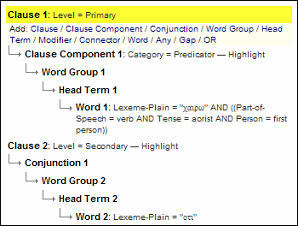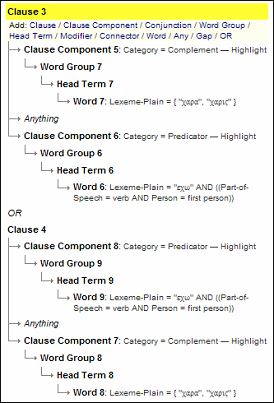Read the first four posts in this series: Intro | 1 | 2 | 3.
Php 4.10 offers an example of the Joy Expression.
Joy Expression in Php 4.10
Description of Form
As with the Request/Petition form, Mullins has questioned if such a thing as the “Joy Expression” exists as a form in the New Testament. White describes the form as follows:
Five formal items may appear in joy expressions: (i) either the verb χαίρω (“I rejoice”) in the aorist tense (cf. Phil 4:10 and P.Giss. 21 in type 3), or the noun χάρις (“joy”) in the accusative case as the object of the verb ἔχω (cf. Philemon 7 in type 3); (ii) an adverb denoting magnitude (πολλήν, μεγάλως, λίαν in the examples diagrammed on p. 94); (iii) either a statement regarding the arrival of a letter or a statement concerning something which was heard; (iv) the object which was heard, introduced by ὅτι; and (v) the vocative.[1]
Mullins rightly takes issue with this based on White’s own examples. Mullins writes:
For the joy expression, [White] indicates five elements without saying which are essential and which are optional; he says they “may appear” in the form. Now, if a form is to be a form, there must be something about it which is basic. Presumably in the joy expression two elements are basic: first “either the verb χαίρω (“I rejoice”) in the aorist tense (cf. Phil 4:10 and P.Giss. 21 in type 3), or the noun χάρις (“joy”) in the accusative case as the object of the verb ἔχω (cf. Philemon 7 in type 3)” and, second, “the object which was heard, introduced by ὅτι”.[2]
To isolate instances of this potential form,[3] the two items Mullins understands as basic are used as search criteria.
The Form in OpenText.org SAGNT
Because Mullins’ first basic item has two relatively different options, two queries are necessary.
First Query[4]
Joy Expression, First Query
- A primary clause with a first person aorist instance of χαίρω as the predicator.
- A secondary clause with the conjunction ὅτι.
Second Query
Joy Expression, Second Query
- A primary clause with a first-person instance of ἔχω as predicator and χάρις (or χαρά) as complement. The order may be predicator-complement or complement-predicator.
No comprehensive list of instances of the joy expression are given by either White or Mullins. Their own examples list Php 4.10 (exemplary of first query) and Phm 7 (exemplary of second query) among the NT instances. The following are located with the queries:
- Instances located by the First Query: 2Co 7.13; Php 4.10; 2Jn 4
- Instances located by the Second Query: 1Ti 1.11-12; 2Ti 1.3; Phm 7; Heb 12.28; 3Jn 4.
Bibliography
Mullins, T.Y., “Formulas in the New Testament Epistles”, JBL 91 (1972), pp. 380-390.
White, J.L., “Introductory Formulae in the Body of the Pauline Letter”, JBL 90 (1971), pp. 91-97.
Notes
[1] White, pp. 95-96.
[2] Mullins, p. 384.
[3] For the very reasons Mullins states, existence of this structure as a literary form are doubtful. At the very least, the definition needs to be worked over and supplemented with non-canonical examples from the papyri.
[4] Instead of two queries, the form could be located with a single query that uses OR to join the two separate queries. They are presented separately to isolate the differences in each portion of the overall query.






